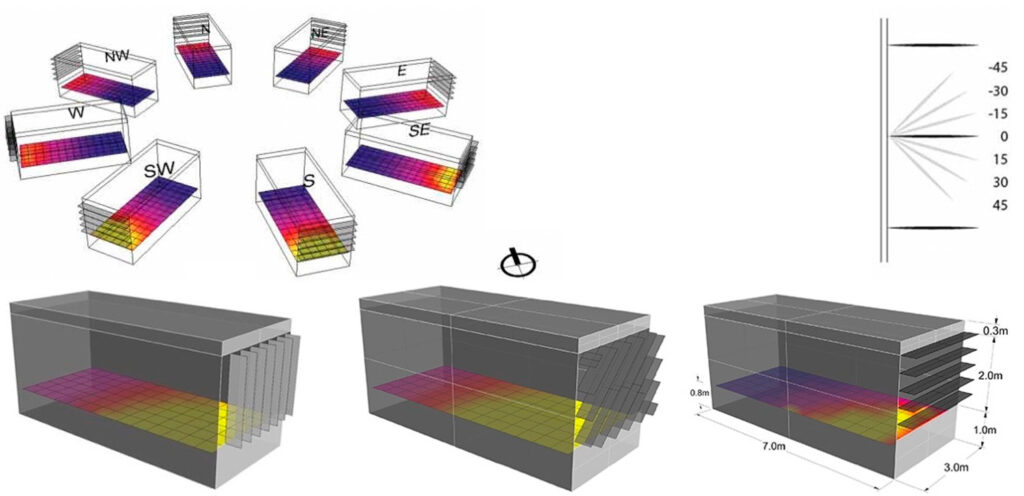
External shading in buildings: comparative analysis of daylighting performance in static and kinetic operation scenarios
Climate-adaptive building envelopes have been receiving increasing interest in recent years. The growing interest can be explained, among other reasons, by the technological advances in control and motion mechanisms and the increasing awareness of building performance and its influence on energy consumption and climate change. Dynamic external shades are one of the earliest examples of climate-adaptive building envelopes. Dynamic exterior shades can potentially optimize the internal illuminance and solar radiation over the building’s façade in relation to the sun’s position. They can also react to disturbances in the sun’s radiation, such as clouds, trees, adjacent buildings, and other urban elements, allowing dynamic adaptation of internal environmental conditions. However, the dynamic operation of louvers also has some limitations. Rapid, automatic movements of louvers can be disturbing. On the other hand, manual changes in louver orientation are highly dependent on the mindfulness of the occupants, who have been reported to be inconsistent at remembering to change the louver’s position, thereby affecting the building’s performance. According to research, people do not operate shades as much as is required to achieve optimal results. Their operation is done weekly or even monthly at most, aiming to improve the visual environment rather than the thermal. Although there is extensive scientific literature about the influence of static and dynamic external shades on internal illuminance and energy consumption, there seems to be a lacuna in the knowledge regarding the contribution of dynamic shading operation scenarios in relation to traditional static shading.
The research was developed in two stages. The first stage defined types of autonomous movement strategies, compared the advantages of these strategies over those of traditional methods of centrally controlled movement; and developed design experiments with physical prototypes that examined the potential of the implementation of the suggested approach using state-of-the-practice technology.
The second part of the first stage of the research developed a computational methodology and tool that could parametrically examine possible decentralized control and operation mechanisms and compare the efficiency of the two control methods in dealing with environmental conditions such as natural light distribution.

The second stage examined and compared various external louvers’ static and dynamic operating scenarios. The analysis was implemented through a method and tool developed in an earlier stage of the research. The method allows designers and decision-makers to check and understand the potential benefits of various positions of kinetic and static external shading elements in close to real-time by working with a database with simulation results generated beforehand. Furthermore, it helps to determine the most convenient setting of external shading elements and to compare the influence of different scenarios of external shading dynamics on illuminance.
Funding:
Autonomous Movement of Kinetic Cladding Components in Building Facades. Principal investigator. Israel Science Foundation (ISF). 390,000NIS (~114,000US$). 2014.
Collaboration:
The project is performed in collaboration with Prof. Guedi Capeluto
Scientific publications that were published on this research:
Grobman, Y.J. Capeluto, I.G, Austern, G., Hatiel, Y. Evaluating the influence of varied external shading elements on internal daylight illuminances. February 3rd, 2020. DOI: 10.3390/buildings10020022.
Pankratov Yekutiel, T. Grobman, Y.J. Controlling Kinetic Cladding Components in Building Facades – A Case for Autonomous Movement. Rethinking Comprehensive Design: Speculative Counterculture, Proceedings of the 19th International Conference on Computer-Aided Architectural Design Research in Asia (CAADRIA 2014) / Kyoto 14-16 May 2014, pp. 129–138. 2014.
Grobman, Y.J., Pankratov Yekutiel, T. 2013. “Autonomous Movement of Kinetic Cladding Components in Building Facades”. ICoRD ’13 International Conference on Research into Design. Indian Institute of Technology, Chennai, India. January 7-9, 2013. Proceedings: Chakrabarti, A., Prakash, R.V. (Eds.), ICoRD’13, Lecture Notes in Mechanical Engineering. Springer India, pp. 1051–1061. Chosen as one of the most distinguished papers in the conference (out of about 200 submitted papers. Fully refereed abstract and paper). 2013.



